The grounds of the Priory can be a scary place when the wind gets up.
 Even the largest trees twist and sway alarmingly; creaking, groaning and occasionally hurling down dead branches. Generally, I think of trees as benign stalwarts but in high winds, I keep a wary eye on them and avoid walking beneath those shuddering arms.
Even the largest trees twist and sway alarmingly; creaking, groaning and occasionally hurling down dead branches. Generally, I think of trees as benign stalwarts but in high winds, I keep a wary eye on them and avoid walking beneath those shuddering arms.
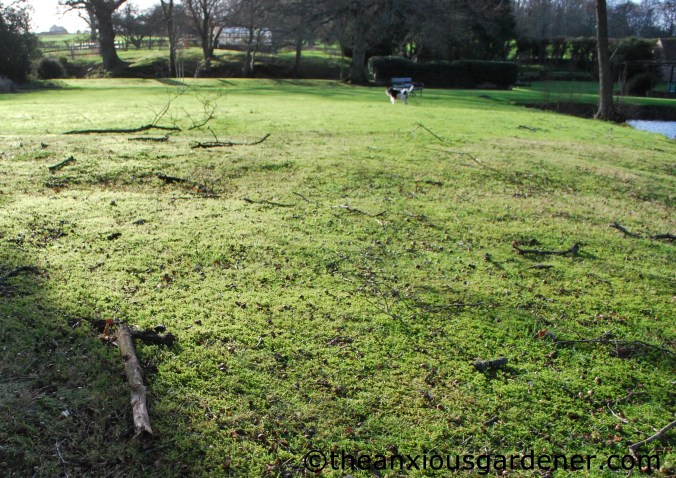 Afterwards, I collect all the branch and twig litter and barrow it off to the bonfire site.
Afterwards, I collect all the branch and twig litter and barrow it off to the bonfire site.
 Except for bigger, heftier branches. These I haul off to the ‘Nissan Hut’.
Except for bigger, heftier branches. These I haul off to the ‘Nissan Hut’.
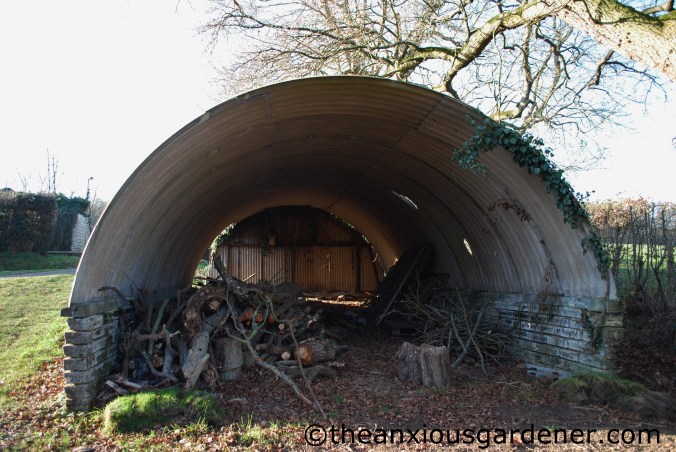 This is one of two that we have and is, I think, a 1940’s construction. It isn’t a building of great beauty (though not without some charm), and as it is gently crumbling, we did consider demolition. But its roof is asbestos and professional removal would have been prohibitively expensive. One day, when one of the huge oak boughs above crashes down, we will have to dismantle it, but in the meantime I’m glad we kept the ‘hut.
This is one of two that we have and is, I think, a 1940’s construction. It isn’t a building of great beauty (though not without some charm), and as it is gently crumbling, we did consider demolition. But its roof is asbestos and professional removal would have been prohibitively expensive. One day, when one of the huge oak boughs above crashes down, we will have to dismantle it, but in the meantime I’m glad we kept the ‘hut. 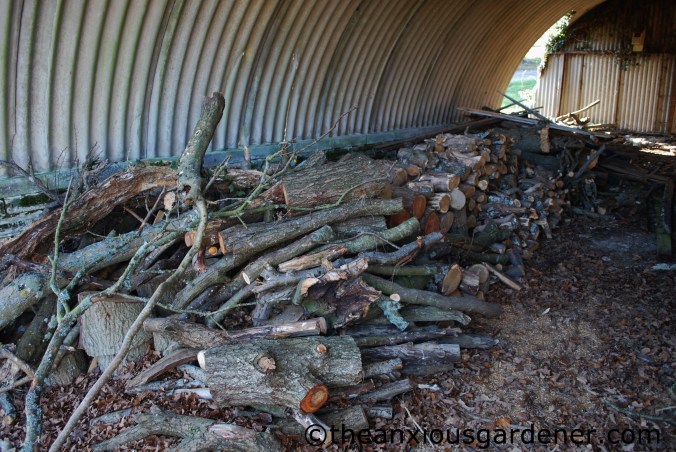 It makes a fine, temporary log store for wind-fallen and pruned branches, as well as any felled trees. It is a dry place to work when it is pouring with rain or …
It makes a fine, temporary log store for wind-fallen and pruned branches, as well as any felled trees. It is a dry place to work when it is pouring with rain or …
… snowing. With the radio on, one might even call it cosy.
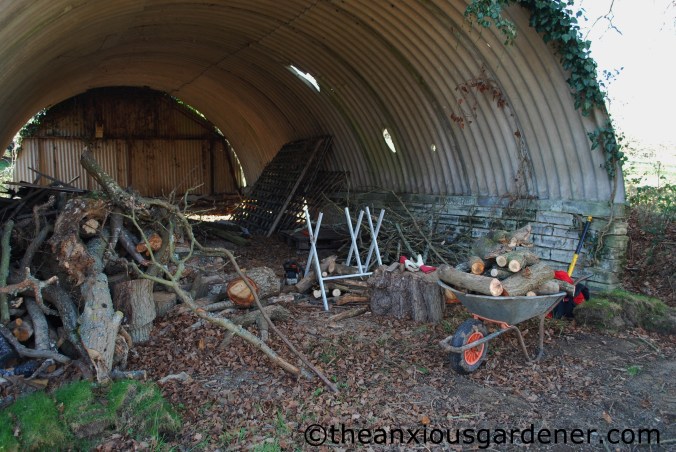 Using an axe is obviously warm work but, perhaps surprisingly, so is wielding a chainsaw. Perfect cold-weather work and lots of it too. Once chain-sawed or split, I take the logs to another outbuilding containing old pigsties.
Using an axe is obviously warm work but, perhaps surprisingly, so is wielding a chainsaw. Perfect cold-weather work and lots of it too. Once chain-sawed or split, I take the logs to another outbuilding containing old pigsties.
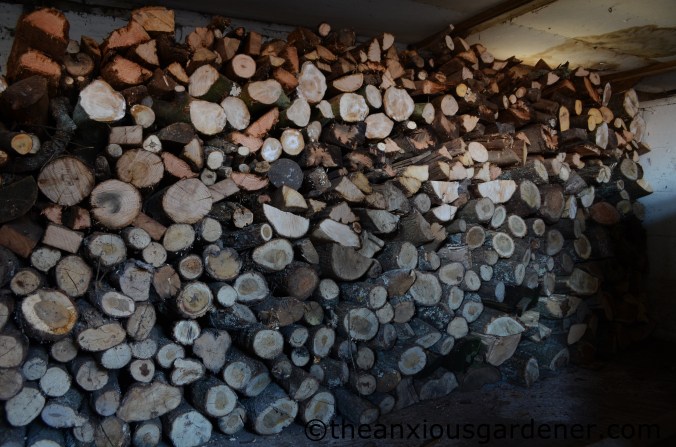 This sty holds all the logs I’ve cut/split this winter: a stack five foot high, fifteen long and five rows deep. We have quite a backlog (!) of firewood, so these logs won’t be burned for three or four years; more than enough time to season.
This sty holds all the logs I’ve cut/split this winter: a stack five foot high, fifteen long and five rows deep. We have quite a backlog (!) of firewood, so these logs won’t be burned for three or four years; more than enough time to season.
I don’t think we shall be cutting any trees down at the Priory this year, but at the Old Forge, I’ve felled half a dozen dead pines.
 Call me over-cautious, call me timorous but working alone with a chainsaw and on a slope, this is about as big a tree as I will tackle.
Call me over-cautious, call me timorous but working alone with a chainsaw and on a slope, this is about as big a tree as I will tackle.
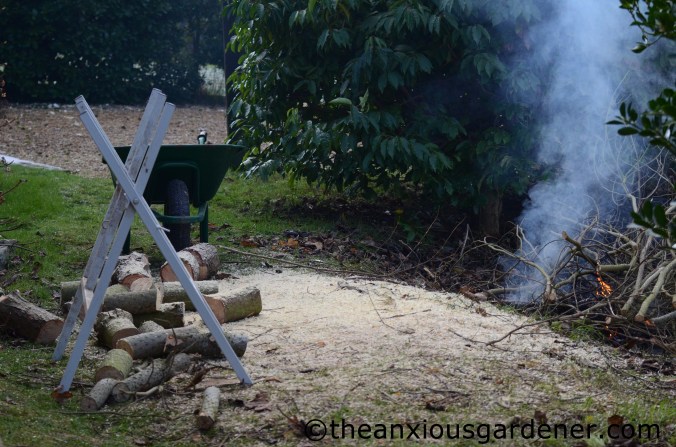 Cut up, mixed with hardwood and seasoned, the pine will eventually be used on the house woodburner.
Cut up, mixed with hardwood and seasoned, the pine will eventually be used on the house woodburner.
Incidentally, if you’re unsure which wood burns best, the following poem is a good starting point.
‘Song of the Forest Trees’
Logs to Burn! Logs to Burn!
Logs to save the coal a turn.
Here’s a word to make you wise
when you hear the woodman’s cries.
Beechwood fires burn bright and clear
Hornbeam blazes too;
If the logs are kept a year
To season through and through.
Oak logs will warm you well,
That are old and dry;
Logs of pine will sweetly smell
But the sparks will fly.
Birch logs will burn too fast;
Chestnut scarce at all;
Hawthorn logs are good to last –
Cut them in the fall.
Holly logs will burn like wax,
You should burn them green;
Elm logs like smouldering flax,
No flame to be seen.
Beech logs for the winter time,
Yew logs heat as well;
Green elder logs it is a crime
For anyone to sell.
Pear logs and apple logs,
They will scent your room;
Cherry logs across the dogs
Smell like flowers of broom.
Ash logs, smooth and grey
Burn them green or old,
Buy up all that comes your way
Worth their weight in gold.*
Holly and ash do indeed make fine firewood and may be burnt ‘green’ – though you shouldn’t have to. Ideally, season all firewood for a year or two. Personally, despite the above, I find Sweet Chestnut burns well – perhaps they mean Horse Chestnut which I haven’t tried. The poem doesn’t mention willow or alder; the Priory has plenty of both and when dry and seasoned, they too make excellent firewood. Burning too much conifer can lead to a build up of resinous tar in your chimney and increase the risk of a chimney fire. And you seriously don’t want that. If you’re ordering a load of firewood, do ask what sort of wood you’re buying: rather a mix of oak and ash than, say, leylandii! And order only from a recommended, reputable supplier. A friend of mine didn’t and had a huge tipper-load of sopping wet logs dumped on her driveway.
Anyway, back at the Priory, I also keep warm by tending to the …
 … seven large compost bins. I turn the contents regularly, though when I built them …
… seven large compost bins. I turn the contents regularly, though when I built them …
 … I hadn’t foreseen how much rainwater they would hold and how that would turn the surrounding ground into a quagmire. Definitely, welly work. After a few minutes pitch-forking, I’ve already removed two of my statutory five-layer, winter clothing.
… I hadn’t foreseen how much rainwater they would hold and how that would turn the surrounding ground into a quagmire. Definitely, welly work. After a few minutes pitch-forking, I’ve already removed two of my statutory five-layer, winter clothing.
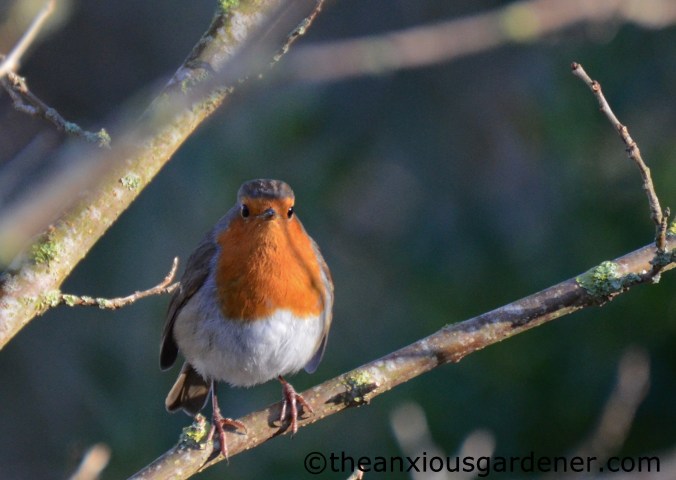 Whenever, I turn compost there will always be a robin close by. Always.
Whenever, I turn compost there will always be a robin close by. Always.
And living in the compost …
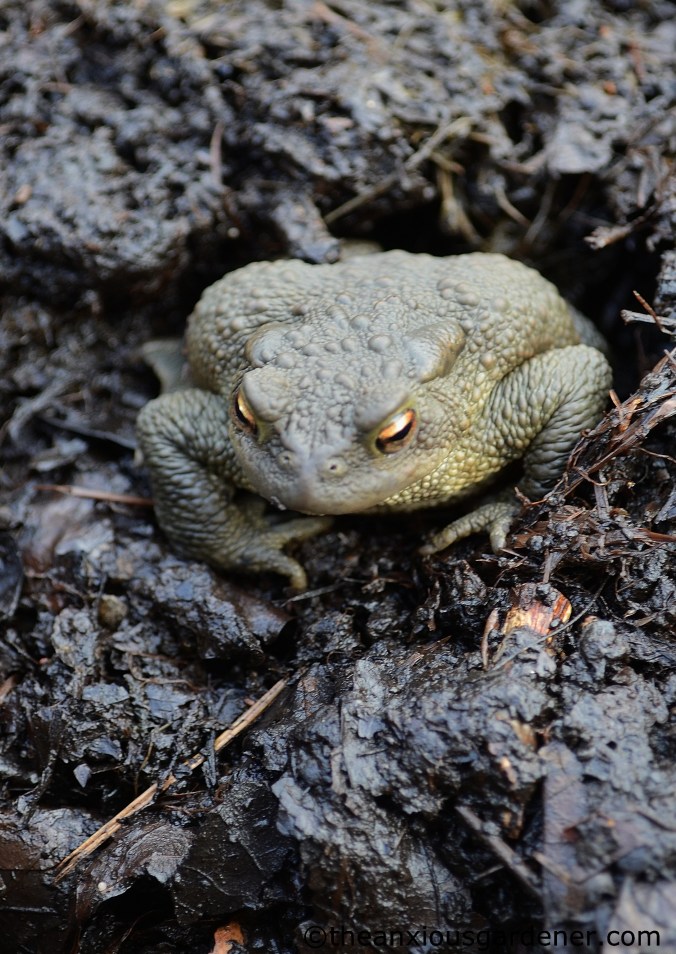 … is a fine, big, fat toad (November 2012). Feeding on my worms, no doubt. I occasionally get mole hills beside the bins too – it seems allsorts of creatures covet my lovely worms. Frogs and toads in the compost would explain why a grass snake (Natrix natrix) has taken to hanging about – (filmed last summer).
… is a fine, big, fat toad (November 2012). Feeding on my worms, no doubt. I occasionally get mole hills beside the bins too – it seems allsorts of creatures covet my lovely worms. Frogs and toads in the compost would explain why a grass snake (Natrix natrix) has taken to hanging about – (filmed last summer).
Beauty isn’t he? And a big ‘un.
As I’m jogging about the estate, doing star jumps, staving off frostbite, I keep an eye on Margaret’s sheep. Occasionally, after heavy rain I’ll see a ‘cast’ ewe, ie one on its back and unable to right herself.
Sorry, not a great photo – I used my phone as it seemed discourteous to leave the poor thing feebly waggling her legs whilst I ran for my camera. Once tugged back upright, she was fine and wobbled away without so much as a thankful nod or glance. Left alone, wet, and particularly pregnant, ewes are often unable to get on to their feet and can die; a soaked fleece is very heavy! So if you see a cast sheep, do help out. It won’t thank you but the farmer will.
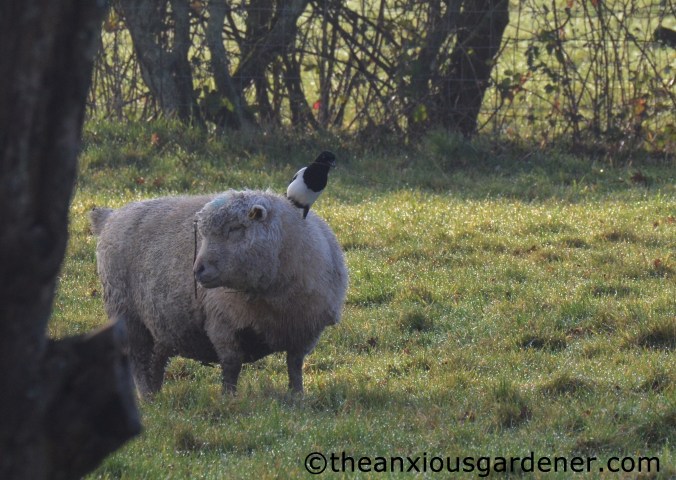 I’d never seen this before. Like an oxpecker on an impala, this magpie is feeding on parasites.
I’d never seen this before. Like an oxpecker on an impala, this magpie is feeding on parasites.
 Initially, I worried it was pecking at the ewe’s eyes. But no, it was just gently probing about for ticks and grubs. It also spent some time diligently probing the ewe’s bottom – I’ll spare you that photo.
Initially, I worried it was pecking at the ewe’s eyes. But no, it was just gently probing about for ticks and grubs. It also spent some time diligently probing the ewe’s bottom – I’ll spare you that photo.
 Happy magpie, happy sheep. Such a simple, symbiotic, Serengeti-ish, Sussex sylvan scene.
Happy magpie, happy sheep. Such a simple, symbiotic, Serengeti-ish, Sussex sylvan scene.
Warms my heart.
* Reproduced from ‘Learning to Live in the Country’ by Kathy Jones
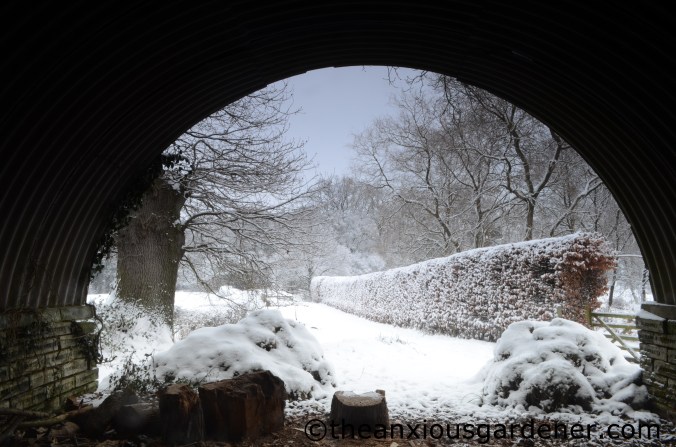
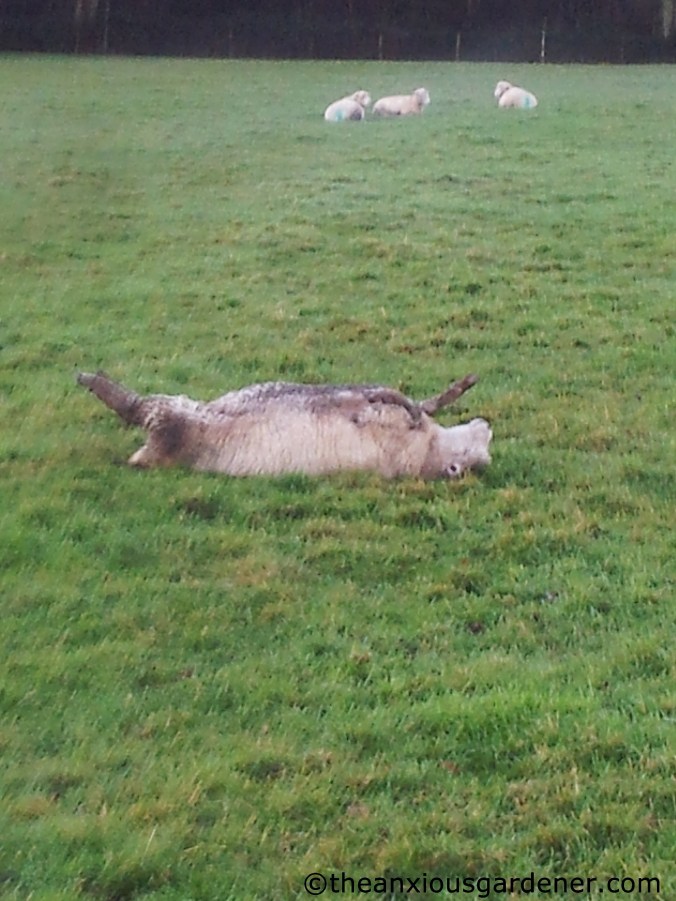
Great photos, good advice and sweet poetry, what more could a blogger ask for? Excellent blog.
LikeLike
Hi GP, thank you and thanks for commenting. Dave
LikeLike
Ah Nissan huts they festoon the island here, bit more sturdy than sheds by many accounts. I had heard ash was very prized as firewood, what a great poem. Ewes (pronounced ‘yows’ here) appear to attention seek in the silliest of situations, well don for seeing her right. A cape would be quite lovely and help to keep you warm….Enjoyed your yomp, I’m with you on the chain sawing, am a bit feart of large trees and slopes. Lovely photos as always! Hope you’ve warmed up!
LikeLike
Hi Fay, I guess Nissan huts shrug off your strong winds and bad weather – and were very cheap to build. And yep – just about warmed up now, thanks. I ended up with so many layers on, I could barely move – looked a little like a podgy starfish. Dave
LikeLike
Hi Dave all looks devine at the Priory , gorgeous and green , cold, beautiful hut and tidy wood stacks………Oh i just love winter ! bonfires, thick socks, hot tea and cake, long walks on weekends, hot soup and chopping wood……….thanks for the reminder.
We are experiencing a really hot, dry summer all a little depressing but for the beautiful mulberries I have been able to pick over the last couple of weeks.
LikeLike
Hi Andrea, yes I’d heard you’ve been having a very hot, dry time of it Down Under. Hope it’s cooled off a bit by now. I do like winter but it is beginning to wear a little thin now. I’m ready for Spring! Dave
LikeLike
I love the shot looking out of the hut at the snow! I’ve never heard that about shepp, which is strange because there are farmers in my family. I like the firewood poem. I’ve burned a lot of those and always liked oak and birch the best-oak for an all night fire and birch for a real good hot one. Excellent post!
LikeLike
Thanks Allen – glad you liked it. Dave
LikeLike
Such a great post and beautiful photos, good job you spared us the magpie and sheep bottom one though, would have lowered the tone significantly. Having all that space *sighs* would be nice. We’ve got a woodburner but it’s a bit of a struggle to find the space to store the wood. I know I shouldn’t but the poor ewe spread-eagled like that did make me chuckle a little. Poor thing but good that you were they to rescue her. Feeling decidedly cooped up at the moment with all the rain and can’t wait to get out and garden again and hear the birds in the trees. It will stop raining at some point, won’t it?
LikeLike
I can’t believe that you chuckled at a poor, stricken, unfortunate, up-side down creature, WW – but I fear you’re not the only one. Glad you liked the post but I’m sorry to say – no. It’s never going to stop raining, I’m afraid. Nope, not ever. I’m going to give up gardening and become a dancer. Or something. I’m that fed up. Dave
LikeLike
Hi Dave! How on earth could an ewe turn herself upside down that way?! Thank God you were hanging around and saved her! That Nissan hut worries me a lot, that roof is really insane, you know? It is dangerous when inhaled and since the roof is coming undone at the centre please hold your breath as long as you work in the hut, ok? I count on it (and I bet that ewe won’t check on you…). Stay warm, little matchguy.
LikeLike
Hi Mr A, asbestos should be quite safe and inert unless you start smashing it up or drilling into it. It’s the dust that is dangerous – so I should be all right unless it is flattened by the oak tree whilst I’m in it (but then I suppose asbestos dust will be the least of my problems!). Hmm, hadn’t thought of burning matches in extremis – I shall bear in mind. And you’re concern is touching. And warming too. Dave
LikeLike
What a handsome toad 😉 and a fine robin. That Nissan hut looks perfect for working in inclement weather. I’ll have to keep an eye out for fallen sheep in our nearby fields: you have been busy! 🙂
LikeLike
Seems no-one has seen a cast sheep baa me, Sara. Go find one would you? Dave
LikeLike
How DO you stand a sheep up, Dave? It looks like an incredibly awkward task, no matter which direction you start from. Can they manage for themselves once they get on to their sides?
(Have you seen “The Incredibles”? You might want to rethink the cape…)
LikeLike
Hey Stacy, easier than it might sound. Dig your fingers in the fleece, and pull out and up from the side. Once they’re sort of on their sides, they kind of manage by themselves (though here’s me talking like a sheep-righting pro – I’ve only done two!). Sorry – cape, mask and rather fetching trunks already ordered. Dave
LikeLike
Love the Nissan hut, what a great place to hide out and chop wood. Will have to bookmark that poem, we are new to “real” fires. We are carefully seasoning the leylandii carcases as warned by our chimney sweep about the tar, but am really looking forward to pruning the holly now, and burning the logs, what fun! As to the sheep, not sure what is more disturbing. Actually, yes I am. My mind is filling in the shots you so kindly left off your blog but told us about anyway. Thank you for that….
LikeLike
The human imagination is a wonderful thing, Janet. Enjoy that missing image – though if you really want, I can readily supply it! Dave
LikeLike
This hard work that you’re putting in is EXACTLY like the work we used to do together, in the sense that it’s the EXACT OPPOSITE. Love reading your posts and taking a daydream to such a beautiful place! Thanks for creating & keeping this! xxx
LikeLike
Hey Lara, ha! Had to read that a couple of times to follow you but yes! It is a different world from the West End and theatre-land isn’t it? Still, I’m often to be found pottering away whilst singing Les Mis songs at full volume. Keeps me amused, anyhow. Dxx
LikeLike
My eldest would covert that nissan hut if he saw it especially with your collection of wood. He turns wood as a hobby so we have piles of branches in the garage and also he has built a wood store.
Love your sheep photos
LikeLike
Hi Helen, well there is some lovely wood in that store including loads of old sweet chestnut posts which I haven’t the heart to burn. I’m going to use them in the garden – just haven’t yet figured out where or how! D
LikeLike
Job well done in chopping all that firewood, and the Nissan hut does look like a cosy place to work. Reading your post today has been relaxing and made me feel cosy now. Lovely mix of things 🙂
LikeLike
Hey Boys, glad you liked it and made you feel cosy too? Result! D
LikeLike
Such a lot to interest me in this post, I had to read it a second time and now I share your posts with my husband. We were very impressed with your wood piles and compost heaps – very sad. However, all the pictures were great and the magpie picking the insects off the sheep’s back is a great series. The magpie is such a clever bird and the sheep is…a sheep. They are not the brightest of animals but very high on the cute stakes.
LikeLike
Hi Amelia, no. I don’t think anyone, with the best will in the world, could describe a sheep as frightfully intelligent. Unlike the magpie! Nice to see the latter doing a good turn and not just being a nest-robber! (for which they have a justified reputation). Glad you liked the post. D
LikeLike
Now i want to burn some pear, apple, or cherry logs! Being a warm climate, sheep are not usually kept here – I never knew one could get on its back and be unable to get back up! What a predicament! The magpie is cute. It looks like the sheep is enjoying its grooming.
LikeLike
Hi Holley, always pleasing to be able to burn fruitwood though it isn’t available too often – thankfully!!! Dave
LikeLike
The rhyme is right. Horse chestnut & elder are lousy to burn, as is willow. The surprisingly bad burner is Scots pine, which you would expect to be good. As for chimney fires – it depends on your flue. There’s a line of good Scots thinking which says a decent chimney fire saves the cost of sweeping it. But if you do have one, never, ever, open the stove to try to extinguish it from beneath. The fire will welcome the extra oxygen and burn down and out – into your living room
LikeLike
Hi Mr K, thanks for that Scots logic. I’d only ever heard how dangerous chimney fires are and how the fire brigade would pump water down your chimney (and into your house) in order to extinguish one. I had thought of willow as a rubbish firewood but have to say it doesn’t seem to be – again so long as it is aged enough. Dave
LikeLike
OMG! that tin half round..seems like Ive seen these in movies..bomb shelters from WWII???? interesting…How awful to be a tipped over sheep….but funny at first…i heard of cow tipping but never sheep!! Its a far cry from my world
LikeLike
Hi Sharon, yeah I’ve heard of people tipping cows but sheep tipping is something they just do all by themselves. They don’t seem to need any help – sheep aren’t the sharpest tool in the box. Dave
LikeLike
Another excellent article. You really capture the ‘feel’ of The Priory so well. Sounds, and looks like a wonderful place!
LikeLike
Thank you – I love the Priory (just in case you couldn’t tell!). Dave
LikeLike
Love your woodpile, that will keep you warm for a few years. Horse Chestnut is the one that is no good on the fire, we had 2 trees come down and the wood gave out no heat at all, had to be mixed with other wood to use it up. Glad the sheep was rescued in time, I’ve heard of it happening down here in Devon but so far have never seen it, she was lucky you wandered by!
LikeLike
Hi Pauline, ah, OK. Thanks for the horse chestnut confirmation. I have a friend who is about to embark on the (expensive) professional chopping up of two big horse chestnuts that were blown over by strong winds. I shall warn him that it may not be worth it – he was intending to use the wood to feed his wood-burner. Dave
LikeLike
Looks like that grass snake appreciates a bit of warmth, with food not far away. I’ve never learned to like snakes so I’m glad he’s in your compost not mine – it would put me off going near the compost bin for some time!! Love the sheep photos.
LikeLike
Yes, you’re absolutely right Caro. I’d forgotten that the snake would love the heat of the rotting compost – as well as snacking on amphibians. Sorry that you (and so many other people) are not a snake person. I just think they are fascinating and beautiful too. I just wished that they didn’t feed on my toads and frogs! D
LikeLike
Interesting to see the cast ewe. Glad you happened along when you did for the rescue. What an oddity. Nice photo of the robin. We have a few that winter over in this area but some migrate and recently there have been large groups of American Robins around the neighborhood–I hope returning and signaling Spring. Have a good day!
LikeLike
Hi, I didn’t even know that you had ‘our’ robins in North America actually – just the American robin. Margaret checks her flock daily – so if I hadn’t seen the cast ewe she would’ve. Dave
LikeLike
The joy of a large estate is that you have lots of space for odd building (usefull buildings). We have thousands of sheep around here and I’ve never seen a sheep on its back, I’ll have to look harder as it must happen here too. Christina
LikeLike
Hi Christina, I think that Italian sheep are well, rangier than ours with less heavy fleeces? (But perhaps that is rubbish). Margaret’s ewes have such big fleeces and relatively short legs that rather like an upturned tortoise, they are unable to right themselves without help. Dave.
LikeLike
At least you are able to keep working outside undercover of the Nissan hut. I am suffering from cabin fever as the snow has been really bad here. Funny how the sheep tolerate the birds on their backs, I’ve seen them on my sheep, yet if I try to get close to pull a bramble off or something, they are off like a shot.
LikeLike
Absolutely Elaine. I did try and remove the piece of bramble off the sheep in the above magpie photos – but she was having none of it and ran for the hills. D
LikeLike
It’s all going on round your neck of the woods…intrigued as to why the sheep are on their backs in the first place, have never seen such a scene before (poor thing!) I have a penchant for sheep so warms my cockles to see such great snaps! :-0)
LikeLike
I think Jane, that when a ewe lies down, the weight of the fleece can tip her over. This was the second one I’ve up-righted in the past few weeks. I’m like a sheep-righting superhero, really. I need a cape though. D
LikeLike